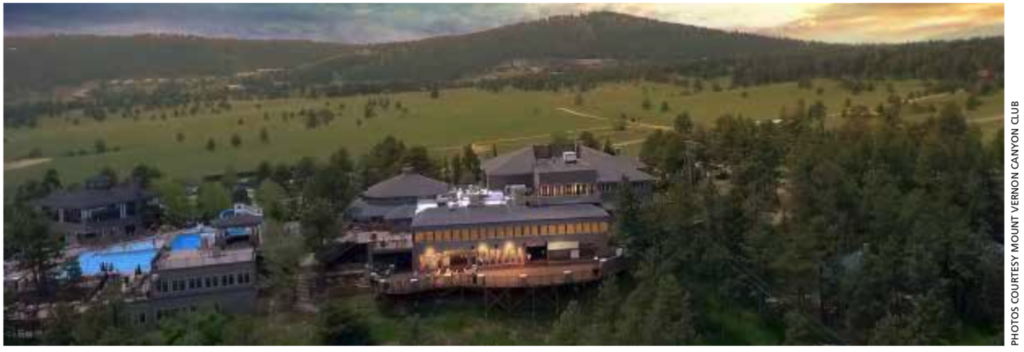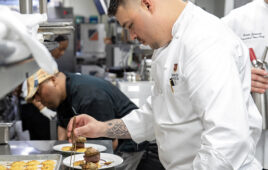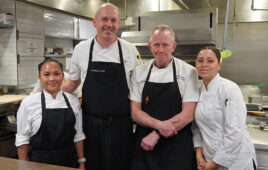The Mount Vernon Canyon Club (MVCC) in Golden, Colo., sits at 7,600 feet and overlooks the city of Denver. Opening in 1923, MVCC has had numerous improvements made to its clubhouse over the years to capitalize on the magnificent views.
Originally called the Mount Vernon Country Club, the name was changed because of its proximity to Mount Vernon Canyon. MVCC offers very active wellness/fitness and swim programs, as well as a very busy, year-round food-and-beverage operation.
In 2016, the club hired Ryan Wolf, a food-and-beverage manager and trained chef, from the Sheraton Corporation. We thank Ryan for taking time during what is an extremely busy period of the year at his club to explain the challenges that come with his dual role of Executive Chef and Food and Beverage Manager at MVCC.
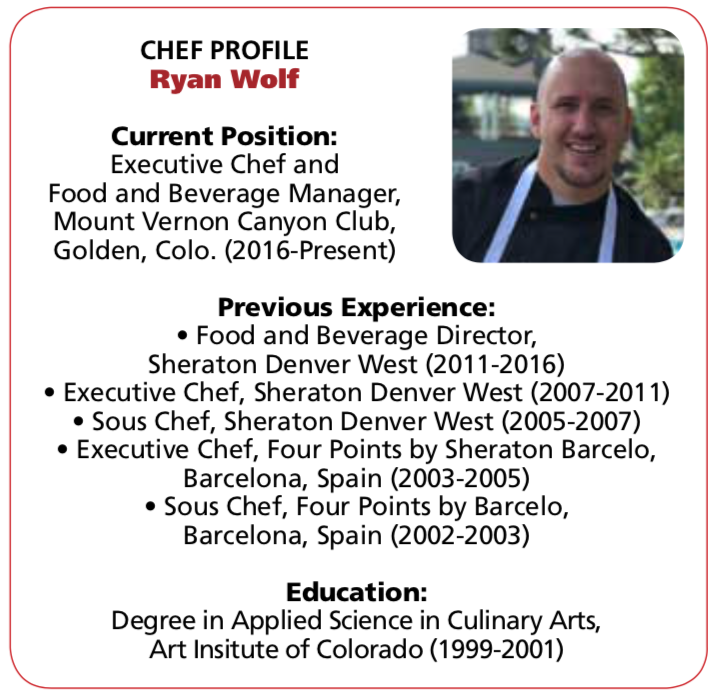 C&RB: Chef, in a dual role of Executive Chef/F&B Manager, how do you decide where to be and when to be there?
C&RB: Chef, in a dual role of Executive Chef/F&B Manager, how do you decide where to be and when to be there?
Wolf: The greatest challenge is knowing where to lend your expertise or physical support on any given day. At times, it’s obvious—for example, if our banquet menus need to be refreshed and optimized for sales compared to our competitors, it’s easy to decide where to concentrate my time.
I have to maintain tight communication between my front- and back-of-house staff on a regular basis. When I became Executive Chef in addition to F&B Manager, the kitchen needed the most guidance. Menus needed refreshing, employees required much more training, and there was a lack of accountability. My focus could have easily become singular and led to a reactive style of management in the front of the house.
Utilizing all communication tools at my disposal—such as weekly team meetings, employee one-on-ones, and nightly dining room reports—are all essential practices for me, to be aware of everything that is going on in the club when I cannot physically be in two places at one time.
C&RB: Is a strong second-line staff that’s willing to take on more responsibility in the front and back of the house also important to help you accomplish what you need to?
Wolf: You absolutely need a more senior-level, high-performing supervisory team in at least one of the areas of responsibility for the dual-role position to work, in my opinion. I’m always struck by the concept of “forming, storming, norming [and] performing.” If your teams in the front or back of the house are inexperienced or simply new to the organization, you are likely in a “forming or storming” phase. In this case, the challenge would simply be too great to be successful in both areas in a dual role.
Conversely, if you have an individual—maybe your Executive Sous Chef who is ready for growth—your kitchen team presumably would be in a performance stage, and that individual would see himself or herself as ready for the next opportunity or promotion. That’s just not possible if the F&B Manager is also the Executive Chef. If your Executive Sous Chef takes another opportunity, the constraints of the Executive Chef job may become too great while you re-form your kitchen team. This means that while at the time a dual-role position made sense, it may be necessary to rehire for a front-of-the-house manager while you reform the kitchen team.
So I don’t think there’s a “one size fits all” scenario that applies to when a dual-role Executive Chef and F&B Manager position is appropriate. I have seen the position work wonderfully when a truly talented individual is ready for the title and can manage multiple roles. I have also seen it work in smaller facilities where having the whole hierarchy or brigade system isn’t financially feasible or necessary.
If the primary reason for having a dual-role manager is a financial one and not based on merit, this usually does not work, because the individual has not been educated enough in both areas. Sometimes promotions are given because of attrition, or simply because someone was great as a chef and he/she is the last person standing after turnover.
C&RB: At times there tends to be a “Protect Your Own Area” mentality in the dining room and the kitchen. Does being ultimately responsible for both help to break down that wall that might exist at another club?
Wolf: I’m sure we all struggle with the “cats and dogs” mentality that exists at times between cooks and servers. At MVCC, we try to focus on quick resolution of the issue for our members’ benefit. That’s not to say we sweep mistakes under the rug, but the middle of service is not the time to debate whether a server verbally did or did not inform the cook of a modifier. We just need the plate corrected immediately!
I tell both my back- and front-of-house staff that we are human and I know we will make mistakes. And I can live with the mistakes, if we take immediate action to properly service and recover our members’ experience. Oddly enough, a member may leave more satisfied if they experience an issue, but get a satisfactory response and acknowledgement, then a member who did not experience an issue at all.
And let’s be honest: Chefs can have big egos and we strive for perfection, but we can misread tickets or under- or over-cook items at times. Whether a server forgets to ring something in or rings in the wrong entrée, or a cook under- or overcooks something, I ask them to “own the problem” and not to hide it or try to B.S. anyone.
I’ve never written up someone for making an honest mistake, so bring it to the front and let’s focus on resolution. Being consistent with this message, as well as holding the front and back of the house equally accountable, builds trust with both staffs and tears down walls.
C&RB: What did you do at Mount Vernon upon your arrival to create contemporary displays to stay relevant, without a lot of dollars to spend?
Wolf: Mount Vernon is no different than most clubs; our budgetary constraints are very real, and this does not allow for the process of modernizing to happen as quickly as I’d like. That being said, there are always lower-budget ways of serving eye-popping buffets.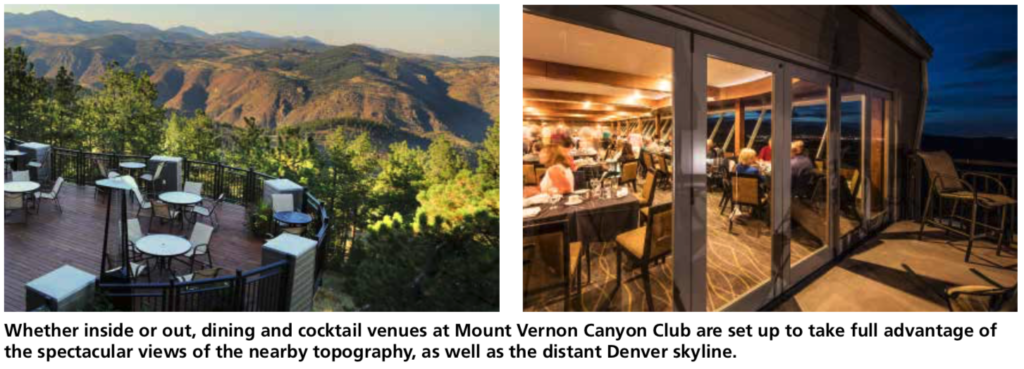
These include simple techniques like making displays on smaller trays, so they can be refreshed more often to keep them looking full and the food fresh. Or maintaining buffets by condensing cold food items to the center, to maintain presentation when food items run low or buffets are nearly over. And for dessert displays, we try to serve individualized portions that seem more personal and creative, versus serving a whole cake or pie.
We also create focal points and get added height by setting a cabaret table behind a six-foot buffet table. This allows us to “flow” bread or fruit-and-cheese-montage displays from one table to the next. We also try to serve chaferless when appropriate, by heating food with sterno on a skillet from below and from a heat lamp on top.
We are also fortunate that we are in the mountains and have a rustic feel. This has allowed me to use cut and polished pine wood as inexpensive risers that are in keeping with the look and feel of the club.
For special events, we take the opportunity to flex our creative muscle. I’ve created “adult cracker jacks” and stuck them on a Velcro wall in mini-Oriental takeout boxes. We’ve made liquid nitrogen ice cream in front of our members. We’ve also made color stations where all the food items were red and matching red décor adorned the buffet.

Despite a pool grill season that averages just 90 days
of service, Mount Vernon Canyon Club still does up to $250,000 a year in food-and-beverage sales at that venue.
Despite a pool grill season that averages just 90 days of service, Mount Vernon Canyon Club still does up to $250,000 a year in food-and-beverage sales at that venue.
C&RB: Tell us about your busy pool operation and what you did to improve the level of product and service there.
Wolf: We are at an elevation of 11,000 feet in the foothills of the Rocky Mountains. Our pool is only open for 100 days a year, and in addition the weather shuts us down for 10 to 15 days a year. This means that at best we average 90 days of service in our pool grill, but we’ve still done up to $250,000 in food-and-beverage sales in a year in that short time.
Adding to that challenge is the reality that we have to rely on a highly seasonal staff, made up of high school and college-aged kids who are not available to work until after opening weekend, due to graduation and other constraints. Then they all return to school in August, when we still have one month of pool operation left.
The club has always offered proper table service in our al fresco dining area, and poolside at the loungers and tables on the deck. Due to the extreme volume at times, we fell into the classic trap of overpromising and under-delivering. We surveyed our members and found that most wanted healthier food options and to have their food served much faster and in a cleaner environment.
We did some market research and found that what we were offering to our members, in terms of the overall size of menu, amount of hot-food offerings and offering proper tableside service, far outpaced the offerings from our competition in surrounding clubs. But what seemed like a competitive advantage was becoming a negative; our members did not demand Vegas-style poolside cabana service, but we were trying to deliver that and failing.
We took the feedback gleaned from the surveys and, armed with the confidence that we offered amenities far above our competition, set out to create a new style of service. Our primary inspiration came from casual, quick-service brands like Panera Bread. We slightly reduced our menu size on the hot side, but increased our cold and healthy snack food and premade items. We limited food consumption to our grill area and al fresco dining areas only. We refreshed our al fresco area with nice planter boxes filled with fresh flowers, new umbrellas, and custom-made wood signage. This welcoming environment also helps to inform our members where to order and where the appropriate dining areas are located.
With the purchase of a merchandising cooler and desk with POS integration, we created a new “storefront” in our grill’s old expo area. Now members are able to walk up, order their food at the POS and exit quickly with their made-fresh-daily cold food or convenience items. Hot foods like burgers and fish tacos are still available, but we give our members a table number and offer to deliver that food when it’s ready.
With this new style of service, we have been able to fulfill our members’ desire for more healthy food options and faster delivery of food and beverages. As a result, we have been able to maintain a cleaner pool deck.
C&RB: You also average 100 weddings in a year at your club. There is no secret to what fuels the demand, given the panoramic views that your property provides. But without a separate banquet kitchen, how can you potentially plate three weddings and also handle a huge a la carte hit at the same time?
Wolf: We make an effort to space service times 30 minutes apart, but as we all know, most weddings go later then the originally agreed-upon service time. This means that we often have multiple weddings colliding with a busy Saturday night a la carte service, and to say this is less than ideal is a gross understatement.
Maintaining tight communication with the event and catering team across multiple parties on multiple floors allows us to flex our meal times. We try to have only one event being plated or one buffet being served at one time, but when that is just not possible, we pool our resources from across the entire club to make it happen. Everyone digs deep and sees it as a challenge to still provide the best possible food in terms of temperature, taste and presentation, despite the chaos.
A key to this is fostering a culture that no one is above doing any job. As F&B Manager, I will wash dishes or clear dirty dishes from tables. If need be, members of our sales team are willing to jump on a plating line and lend a helping hand.
From a sales perspective, we are targeting whole-day buyouts of the club and a “less is more” approach. Our goal is to do fewer weddings that pay more, so we set our staff up for success and do not exceed our capabilities.
Featured Recipes from Chef Ryan Wolf are also available here:
Ricotta Gnocchi with Basil Oil
Pollo a la Brasa

